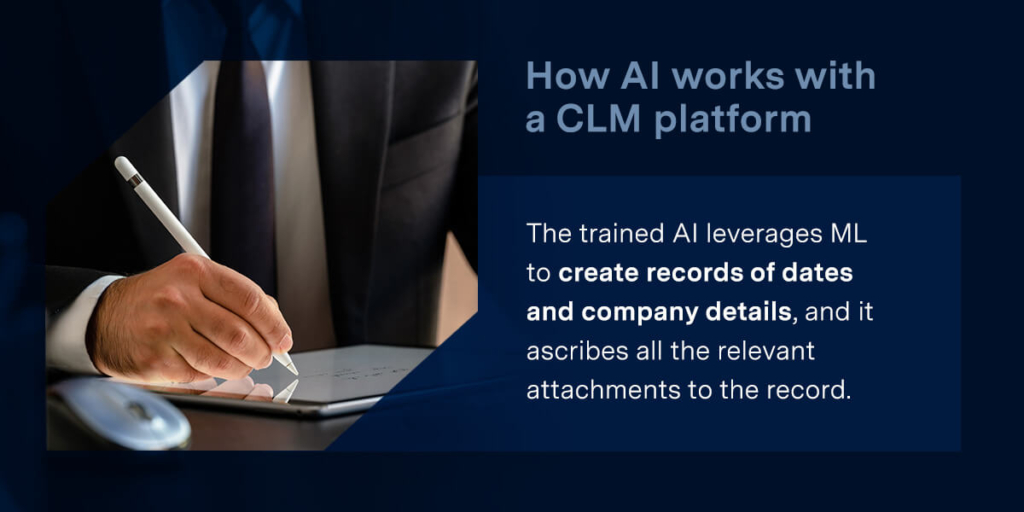
What is Contract Analysis & Why it Matters
Contracts can be a goldmine of data and information on how to successfully run your business. Getting to that data is the problem that a CLM and AI help solve.

Contracts can be a gold mine of data and information that reveals how to run your business successfully. Getting to that data can be tricky, but Contract Lifecycle Management (CLM) and Artificial Intelligence (AI) can help.
The importance of contract analysis
Data and analytics help drive smarter decisions, and many companies have become increasingly creative to get the information they seek. Even so, you may have overlooked one of the most data-rich resources in your organization — contracts.
Contracts provide a wealth of information, including expiration and renewal dates, assets and maximum liabilities, payment terms, regulatory risks, and acceleration clauses. They’re a read-receipt of what happens in a business, capturing every transaction, customer, vendor, and potential partnership.
Contract analysis is the process of assessing and tracking information within a contract throughout its lifecycle. This allows businesses to:
- Flag what’s worked and identify improvement opportunities
- Mitigate risk.
- Save costs.
- Enhance future contracting processes
- Pinpoint errors
- Improve compliance
- Create better negotiation strategies
Consider this contract analysis example: A tech company is entering into a partnership with an athletic brand to develop a line of fitness wearables. Contract analysis allows each company to identify clauses that may expose them to risks, such as unclear deliverables.
The role of CLM platforms in contract analysis
An estimated 60%-80% of business transactions are regulated by written agreements, and typical Fortune 1000 companies may manage as many as 40,000 active contracts at one time. With numbers like that, it’s easy to see how contract analysis can become difficult — and why the CLM solution market is projected to reach $3.47 billion by 2030.
A CLM platform can help companies view contract data in aggregate and recognize patterns. They can also leverage AI and Machine Learning (ML) to reduce the manual work needed to extract value from contract data. Businesses investing in a CLM platform can enjoy benefits like enhanced efficiency, collaboration, security, and risk management.
The challenges of imprecise contract language
Contract management tools are often most effective in resolving problems related to imprecise contract language. When the contract language does not reflect the current state of your company or current laws and regulations, you have an inaccurate view of your business state.
For example, contract clauses that lack specific language could expose your business to unwanted breaches and unforeseen outcomes. Even if the legal team dedicated time to drafting the exact right clause to suit each precise need, the work to ensure these versions are used correctly for all future contracts may not have been done.
The same issue can extend to protection around liabilities and limited or missing language on terminations. Another area of exposure can occur when agreements that are exclusive or require disclosure among parties have not been fully met. These put the organization in regulatory or legal trouble. At a minimum, they threaten the ongoing success of that business relationship.
A contract management platform addresses these concerns by increasing the visibility of contract data across an organization and ensuring the use of contract templates and clause libraries. Users can easily run contract analysis reports to assess threats and determine which contracts fall outside the bounds of the organization’s requirements.
Interpreting the contract lifecycle steps correctly
Before accurately analyzing a contract lifecycle, you need a way of capturing every step of the lifecycle.
Without a robust contract management solution, companies are prone to misinterpreting the contract lifecycle steps and associated responsibilities. This may lead to the following challenges:
- Delays in executing timely approvals
- Confusion regarding renewal dates
- Discontinuing the incorrect agreements
- Failing to identify agreements that should be terminated or not renewed
On the procurement side, it can result in failure to create new performance requirements that would address vendor concerns or hold the vendor to better standards.
CLM tools solve key challenges associated with initiating, approving, and monitoring, resulting in a reduction in:
- Purchasing costs
- Accelerated sales cycles
- Visibility of legal and compliance threats
How AI works with a CLM platform
Once you have an accurate picture of your processes from a CLM solution, the real fun begins. The system’s AI obtains totals and can report on each agreement, document, and other data. You can also use conversational AI technology, such as chatbots, to understand the nuances of contracts. For example, you might ask questions like, “What agreements are due for renewal next month?” Without having to conduct a manual count, the user has the contract management analytics that they need in minutes.
AI can also extract text and data, allowing users to upload thousands of documents from older, expiring systems. The trained AI leverages ML to create records of dates and company details, and it ascribes all the relevant attachments to the record.

AI can also address concerns about inconsistency in contract clauses by automatically assigning a risk score. AI identifies and extracts the clauses from each agreement and compares them to the organization’s clause library. It completes an analysis of the threat the contract has to the organization. For example, say the legal team has three agreements stacked up for review, and the contract analysis platform has determined two of them have a low-risk score. The team can address low-risk cases quickly and keep moving before circling back to the complex contract as time allows.
Frequently asked questions about contracts and contract management
Consider the answers to these contract questions.
1. What are the 8 stages of a contract?
There are eight stages of a contract:
- Contract request and initiation
- Drafting the contract
- Reviewing and negotiating terms
- Approvals
- Contract execution
- Obligation and compliance management
- Contract renewal or termination
- Record keeping
You can learn more about the contract lifecycle stages in this blog post.
All of these stages are captured in a CLM. The more robust the features, the better the user experience and the benefits to operations.
2. What are the 4 elements of a contract?
Contracts have four elements:
- Offer: The offer does not need to contain all the details but must contain all the critical information a legal professional would ask — enough to move discussions to the next step.
- Acceptance: This is a final and unqualified acceptance of the offer.
- Intention to create a legal relationship: This determines that all parties intend to enter into a legally binding agreement.
- Consideration: This is usually represented by an exchange of money.
All of the essential components here are seemingly straightforward. However, overlooking or mismanaging one stage or element puts the transaction, possibly the organization, at great risk. A CLM can help companies leverage analytics to stay on top of current operations and pinpoint problems as they arise.
3. What is the difference between a contract review and a contract analysis?
Contract analysis is the process of tracking agreement information throughout the contract lifecycle. Contract reviews analyze contracts as stand-alone business documents and make sure both parties’ interests are properly represented and protected.
A reliable CLM solution will also support you during the review stage. It will remove the manual steps of ensuring all the proper terms and information are included. However, if you are just beginning your business, it is a good exercise to understand the fundamental elements of a contract before you start deferring to your platform to do the work for you.
In general, it is best to engage the services of a trained legal professional to review any binding contract, particularly if there are any contract terms or clauses that are unfamiliar or cause you hesitation. While this once required relying on a law firm, now, you can engage these services easily through certified direct providers, often at a reasonable hourly rate.
4. How do you choose a CLM solution and implement it effectively?
Consider these tips to choose a CLM tool and avoid common implementation mistakes:
- Research firms to create your shortlist
- Consult review-based websites like G2 — but don’t rely on them too heavily
- Define your goals upfront, such as enhancing compliance or reducing the contract cycle
- Consider the vendor’s implementation success rate, whether their solution can scale according to your needs, and how they’ll support you throughout the project.
About Agiloft’s industry-leading, data-first CLM platform
Agiloft’s data-first CLM Platform is designed to streamline contract processes and liberate the data stuck in all the agreements you sign. Our no-code interface means you don’t need technical expertise to optimize your contract processes, and real-time dashboards give you the insights you need to make important decisions. Additionally, our AI Platform enhances contract lifecycle tasks for accuracy, compliance, and alignment with business objectives.
Contact us
At least 97% of our customers retain our services every year, and we are dedicated to creating long-term partnerships with everyone who invests in our technology. We’ve also been named a Leader in the Gartner® Magic Quadrant™ for CLM for five consecutive years.
Learn more about Agiloft’s data-first CLM Platform, or request a demo today.
Recent
Posts
Discover how our integration with Screens enhances AI contract review, negotiation, and confidence with AI on the inside™.
Your CLM needs to be able to flex and scale as much as your organization does as it grows. Learn how to future proof your CLM.
Learn how to use contract data and data-first CLM to promote your legal team to true, strategic business drivers, influencing future decisions and process change.





